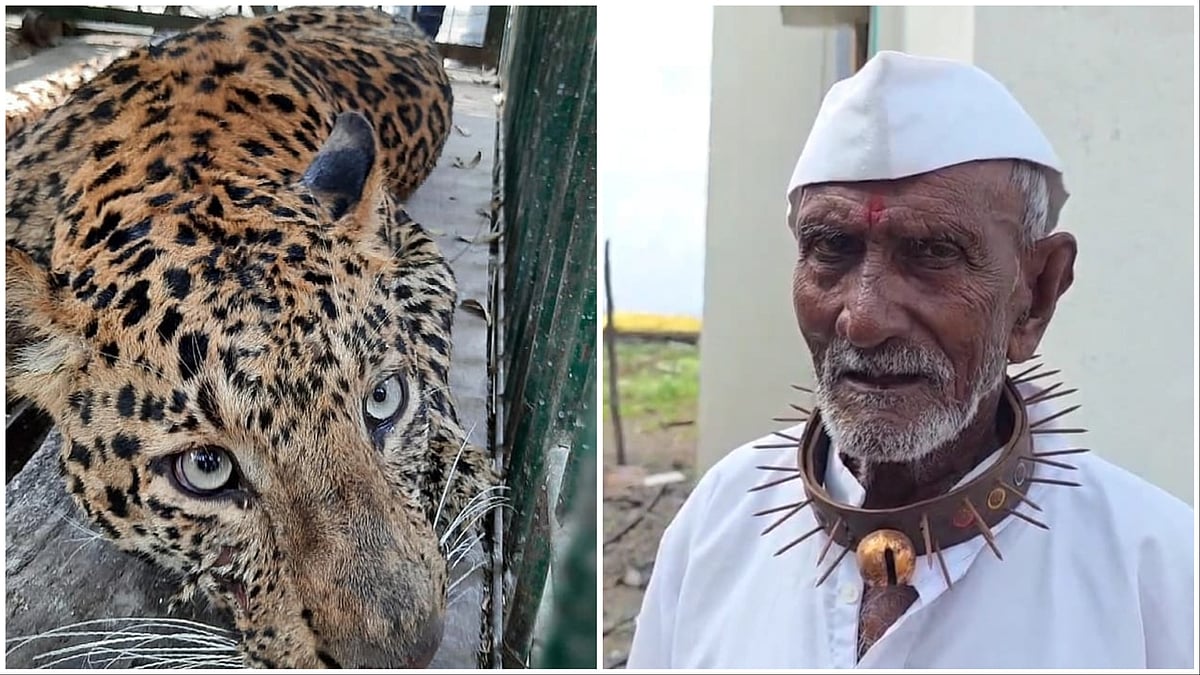Pune: Villagers In Leopard-Hit Shirur Tehsil Wear Spiked Collars To Survive Fatal Attacks
Pimparkhed village, approximately 40 km away from Shirur and around 75 km away from Pune city, is a village where most people are involved in farm and dairy-related activities. With sugarcane being a top crop in this area, leopard presence is heavy, just like other tehsils of the district on this side

Pune: Villagers In Leopard-Hit Shirur Tehsil Wear Spiked Collars To Survive Fatal Attacks | Sourced
Pune: Leopard-prone areas of Pune District have been in a state of terror, as leopard-human conflicts have been growing recently in Junnar, Ambegaon, Shirur, and Khed tehsils. With three fatal incidents in the last 30 days, residents of Shirur tehsil's Pimparkhed village, where the leopard-human conflicts are considered a norm, are taking desperate yet unique measures to save their lives.
Pimparkhed village, approximately 40 km away from Shirur and around 75 km away from Pune city, is a village where most people are involved in farm and dairy-related activities. With sugarcane being a top crop in this area, leopard presence is heavy, just like other tehsils of the district on this side. To save their lives, residents can be seen wearing spiked collars around their necks to protect themselves.
What's the Logic Behind Spike Collars?
Due to the availability of ample water and livestock, many times, leopards find themselves having an easy hideout in the farms in these areas. As people have to work in these farms, it increases the chances of human-leopard conflicts. With leopards desperate for food and humans' overall tendency to panic when they see predators like them, many times, humans stand no chance in these conflicts.
ALSO READ
A Forest Department Official explained, “Leopards are known to attack the neck of their prey. Being very fast, they are not most of the time used in endurance-based fights. Many times when people work on farms, they bend down or sit down for work. It's a dangerous situation, as leopards tend to attack things below their eye level. It includes children, livestock, and people seated or bent down.”
“This collar thing might work for residents, as once Leopard's first strike goes in vain and he realises the real stature of the person it's attacking, he may back off. Most of the cases involve a leopard biting down on a neck and killing it. The spiked collar would not just protect you but might also injure the leopard in some way. Also, it's designed in such a way that there is a ghungroo (small metallic bells) attached to it, whose noise scares the leopard away,” said the Forest Department official.
Wolf Collars Utilisation
Shepherds in Europe first used spiked wolf collars to tie around their dogs' necks. Its history traces its origins to somewhere around Spain and Italy. Shepherds use dogs to protect their sheep from foxes and wolves. However, sheep don't put up a fight, unlike dogs. So to protect their dog from dying instantly, the owners came up with this collar.
This same idea has been used by residents of Pimparkhed Village. They have observed the leopard's behaviour for years. Although against their wishes, leopards have been encroaching upon their lands for quite a long time now. They have noticed that many times a leopard sneaks up on you and instantly attacks you. It will wait to finish you off within 10-15 seconds, and if you survive that attack, your life is saved.
Arjun Mane, a resident of Pimparkhed village, told The Free Press Journal, “We were given some guidelines by the police and forest department about not going out alone or never leaving children alone. We looked something up on the internet and decided to try these spike-up collars once. Leopards attack the neck, and we are protecting it. If this works, then it will save many lives of our villagers.”
Efforts Of Villagers & Government Promises
With three fatal leopard attacks in the space of 30 days, villagers from Shirur, Ambegaon, Junnar, and Khed tehsils had staged a rasta roko protest in Manchar on the Pune-Nashik Highway. The angry villagers had demanded that Deputy CM Ajit Pawar and Forest Minister Ganesh Naik personally visit the areas. Slogans were raised against the government.
ALSO READ
In the following days, several developments took place:
- Residents demanded shoot-at-sight orders for leopards, their relocation from the area, and sterilisation measures.
- Forest Minister Ganesh Naik announced funds for the immediate installation of 1,200 cages and traps, along with AI surveillance and other technology-based measures to prevent leopard attacks.
- Two leopards were caught last week: one trapped in a cage, and another, suspected to be man-eating, was shot dead by a sharpshooter.
- Deputy Chief Minister Eknath Shinde visited the grieving families, offering condolences and promising long-term solutions.
- However, Ajit Pawar, the district’s Guardian Minister, and Forest Minister Ganesh Naik are yet to visit, despite repeated demands from local residents.
RECENT STORIES
-
-
-
-
-